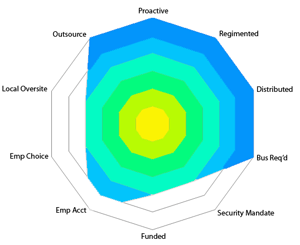Watching the Herd
Employee Usage Monitoring
From our experience most of the excess usage charges on invoices are unintentional and caused either by an uninformed user stumbling into new terrain on their smartphone or bad assumptions that all services are free of charge because they are included and available on their device. Since employees don’t have to pay for or even see the residual effects of their usage, they often draw incorrect conclusions about what usage may or may not incur charges on their mobile devices.
Studies have shown that even the threat that management has oversight to monthly usage activities can initiate a more cautious and prudent usage of an employee’s wireless device. An even more effective method than the mere threat of oversight is actual monthly reviews of employee usage and charges by their direct management. There are a variety of tools in the industry that can achieve this objective although a smaller set of solutions, such as MobilSentryTM, possess the ability to flag and generate alerts related to specific usage policy violations. For a busy manager, the information is much more likely to be viewed if presented in a way that filters out the always present noise in a wireless carrier invoice.
method than the mere threat of oversight is actual monthly reviews of employee usage and charges by their direct management. There are a variety of tools in the industry that can achieve this objective although a smaller set of solutions, such as MobilSentryTM, possess the ability to flag and generate alerts related to specific usage policy violations. For a busy manager, the information is much more likely to be viewed if presented in a way that filters out the always present noise in a wireless carrier invoice.
Whether you wish to classify some usage as personal or consider it abuse of a company asset, there are some particularly fruitful categories to monitor. Our experience has been the topics indicated below typically represent the most interesting areas to monitor on monthly invoices. Some of these represent painful financial excesses and others such as downloads may elicit a more emotional response.
Fraudulent/Excessive Usage – Abuse can cover all dimensions of a mobile device including voice, data and messaging. Sometimes this behavior flies beneath the radar because usage is pooled and one device’s spike may be absorbed within the pool, mitigating overage charges and visibility. In particular, now with Group Share plans that include unlimited domestic voice and messaging, there is a risk that a lost or stolen phone running at high volume may not raise suspicions because its usage is obscured by pool buffers.
An effective tool to flush out devices being abused is to flag devices with rapid change in usage one month to the next. Your Mobility Management Solution should include some form of variance reporting to flag statistically significant growth in any usage area including voice, data and messaging.
International Usage – Just because an employee is vacationing in a country where their device service continues to work does not imply that the company condones its usage or will agree to pay international charges. These types of charges can be the most painful and likely the most easily identified due to the fact that they will typically come in large noticeable expense entries on the invoice. Often these expenses are occurring at the Pay-as-you-go rates without the moderating effect of international features. An appropriate policy in these cases may be full reimbursement by the employee.
Downloads – The magnitude of these charges rarely reach the levels of international overage but they are more irritating perhaps due to the fact that it is wholly unnecessary as a business expense and may actually be an indicator that the employee is not completely focused during work hours on their job. Not all carriers make the download package description explicit but those that do can provide some illuminating insights into the distractions your employees may be encountering during the day.
Directory Assistants Charges – Wireless carriers seem to enjoy raising these prices frequently and adding services to attract more usage. If someone’s job function puts them constantly on the road then this may be an expected efficiency needed for some mobile employees. However, for some it just represents unneeded charges when other means are easily available such as today’s smartphones where there are a multitude of free apps that will give phone numbers almost as easily as dialing 411.
Corporate 1-800 and Toll Numbers – Your organization may have 1-800 service lines for clients to call toll free. Employees that use these lines are only causing duplicate charges each time they call, with charges on their mobile device and charges on the corporate toll number. Automation can assist in tracking monthly calls against specifically identified numbers.
All of these categories can provide important insight on areas of unneeded business charges and oversight and inspection can increase the overall health of your mobility program.

